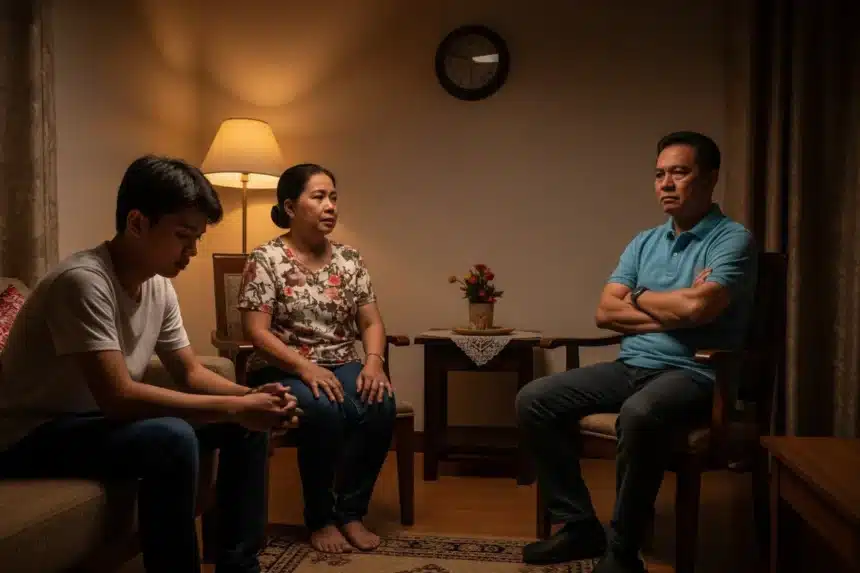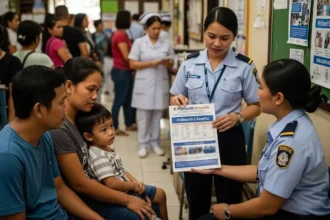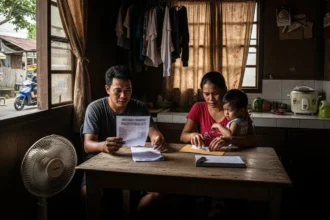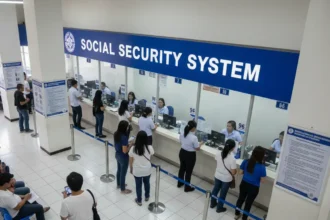Mental health is finally gaining attention in the Philippines, yet many Pinoy households still find it hard to talk about depression, anxiety, or therapy. It’s not that Filipinos don’t care – it’s that decades of cultural beliefs, religious framing, and lack of awareness have made mental health feel like a taboo subject. When a child says they feel “burned out” or “overwhelmed,” some parents dismiss it as arte lang or kulang ka lang sa dasal.
- 🌏 Cultural Roots of Mental Health Stigma
- 📊 Table: Common Stigmas About Mental Health in Pinoy Families
- 🏠 The Family’s Role in Silence and Suffering
- 🧩 Breaking the Silence: What Families Can Do
- 🌍 How Other Countries Handle Mental Health
- ✅ Practical Steps to Reduce Mental Health Stigma at Home
- 💡 Frequently Asked Questions (FAQ)
- Why This Matters for Every Filipino ❤️
- 🧠 References
But silence can be dangerous. The World Health Organization (WHO) estimates that one in five Filipinos may experience mental health challenges in their lifetime. Still, too many suffer quietly because they fear being judged, misunderstood, or labeled as weak. For a culture that prides itself on resilience (laban lang), mental health struggles often clash with the Pinoy ideal of toughness.
This article unpacks why stigma persists, how it impacts families, and what Filipinos can do to break the silence and start healing conversations at home.
🌏 Cultural Roots of Mental Health Stigma
The Unspoken Struggle: Why Mental Health is a Taboo in Many Filipino Families
In many Filipino households, mental illness is not viewed through a medical lens but through a cultural one, where it is rarely seen as a legitimate health condition. Instead, it is often misinterpreted and stigmatized, associated with personal failings such as a weak character, a lack of spiritual fortitude, or even simple laziness. This deeply ingrained mindset is not born from a lack of care, but from a complex interplay of powerful cultural factors that have shaped the Filipino psyche for generations.
Religious Framing: A Test of Faith
In a predominantly Christian nation, faith is a cornerstone of life and a primary source of strength. However, this deep religiosity can sometimes lead to a misinterpretation of mental health struggles. Instead of being seen as a neurochemical imbalance or a psychological condition, depression or anxiety can be framed as a spiritual trial or a punishment for sin. A person struggling might be told they simply “lack faith” or need to “pray more.” While spirituality can be a powerful coping mechanism, this perspective tragically dismisses the need for clinical intervention and places the burden of healing solely on an individual’s spiritual “worthiness,” adding guilt to their existing suffering.
Machismo Culture: The Pressure to “Man Up”
The concept of pagkalalaki, or manhood, plays a significant role in how emotions are expressed, particularly among Filipino men. The traditional machismo culture dictates that men must be the unwavering pillars of the family-strong, stoic, and resilient providers who never show vulnerability. To admit to feelings of sadness, anxiety, or despair is often seen as a failure to live up to this ideal. Men, in particular, are told to “man up” (magpakalalaki ka) and suppress their emotions. This immense pressure to appear strong at all times prevents many from acknowledging their struggles, let alone seeking help, for fear of being perceived as weak or less of a man.
Hiya (Shame): Protecting the Family’s Face
Hiya, or a deep sense of shame and social propriety, is a powerful force in Filipino society. It is intrinsically linked to how one is perceived by their community. Because mental illness is so heavily stigmatized, having a family member who is struggling is often seen as a source of embarrassment that could bring shame upon the entire clan. Families fear being the subject of gossip (tsismis) among relatives and neighbors. This fear of judgment-of being seen as having “failed” in some way-often leads them to hide the problem, creating a conspiracy of silence. The need to protect the family’s reputation can tragically outweigh an individual’s need for professional help.
Pakikisama (Harmony): Don’t Rock the Boat
Pakikisama is the cultural value of maintaining smooth interpersonal relationships and group harmony. While it fosters a sense of community, it can also discourage open confrontation and the discussion of “heavy” or uncomfortable topics. Bringing up a mental health issue is often seen as “rocking the boat”-disrupting the peace and burdening others with one’s problems. To preserve the appearance of a happy, functioning family, deep-seated issues are often swept under the rug. This creates an environment where individuals feel isolated, believing their struggles are a private burden that should not be shared, lest they disrupt the harmony of the group.
The Dangerous Consequences
These powerful cultural barriers create a dangerous chasm between suffering and treatment. Instead of seeking help from a psychiatrist or therapist, many Filipinos are encouraged to turn to herbal remedies, traditional spiritual healers (albularyo), or, most commonly, simple denial. Professional help is often seen as a last resort, only to be considered when the situation has escalated to a severe crisis point. This delay in treatment allows the condition to worsen, making recovery more difficult and perpetuating a cycle of silent suffering within the community.
📊 Table: Common Stigmas About Mental Health in Pinoy Families
| Common Belief | Why It’s Harmful | What’s Closer to the Truth |
|---|---|---|
| “Depression is just sadness.” | Oversimplifies a medical condition. | Depression is a disorder involving brain chemistry. |
| “Therapy is only for the rich.” | Stops people from seeking affordable options. | NGOs and public hospitals offer low-cost counseling. |
| “Anxiety is just being overdramatic.” | Invalidates real symptoms. | Anxiety disorders can cause severe physical effects. |
| “Prayers alone can cure everything.” | Faith helps, but ignoring treatment prolongs suffering. | Combining faith with medical/psych support is best. |
🏠 The Family’s Role in Silence and Suffering
Families are supposed to be a person’s first support system, but in the Philippines, they can sometimes become the biggest barrier. Parents may dismiss symptoms as arte, siblings may joke about it, or relatives may spread gossip when someone goes to therapy. These reactions not only invalidate the person but also push them deeper into isolation.
Children often grow up learning to hide their struggles because they fear disappointing their parents. Teens pressured by academics may quietly endure panic attacks. Overseas Filipino Workers (OFWs), who already feel isolated abroad, may hesitate to open up to family back home, worried they’ll just be told to “tough it out.”
When silence replaces understanding, the stigma becomes more damaging than the illness itself.
🧩 Breaking the Silence: What Families Can Do
The first step is acknowledging that mental health is real health. Families can take small but meaningful steps to support their loved ones:
- Listen without judgment – Sometimes, just being heard helps more than advice.
- Normalize conversations – Talking about stress, burnout, and emotions should be as common as talking about colds or fevers.
- Encourage professional help – Remind loved ones that therapy is no different from going to the doctor for flu.
- Respect privacy – Not everything needs to be shared with the extended family or barangay gossip.
Even small changes in attitude can break generational cycles of stigma.
🌍 How Other Countries Handle Mental Health
Looking at other nations gives perspective. In countries like Japan and South Korea, stigma also runs deep, but aggressive government campaigns and school-based interventions are slowly changing attitudes. In the United States and parts of Europe, therapy is now normalized, with workplaces even offering mental health days.
By studying these examples, the Philippines can learn how policy + cultural change can slowly dismantle stigma.
✅ Practical Steps to Reduce Mental Health Stigma at Home
Changing deeply ingrained cultural views on mental health begins with small, consistent actions within the family. The goal is to create a safe environment where vulnerability is met with compassion, not judgment. Here’s a more detailed look at how to implement these practical steps at home.
1. Start Conversations During Casual Family Time, Like Meals
The dinner table (hapag-kainan) is often the heart of the Filipino home, a natural gathering place where families connect. Use this relaxed, non-confrontational setting to gently introduce the topic of mental health. You don’t need to make a grand announcement. Instead, you can start small by mentioning a news story, a public figure, or a celebrity who has recently spoken about their mental health journey.
- How to do it: Say something like, “I saw an interview with [Celebrity’s Name] talking about their anxiety. It’s brave of them to share that,” or “I read an article today about how stress affects our health, not just physically but mentally too.” This approach normalizes the topic, framing it as a common human experience rather than a personal failing.
2. Watch Movies or Shows About Mental Health Together
Media can be a powerful and accessible tool for education and empathy. Watching a movie or a TV series that accurately and sensitively portrays mental health conditions can serve as a “third-party” conversation starter. It allows family members to discuss the characters’ struggles, which can feel much less intimidating than talking about their own.
- How to do it: Pick a well-regarded film or show (like Inside Out for explaining emotions to all ages, or a drama that features a character with depression). Afterwards, ask open-ended questions like, “What do you think the character was feeling?” or “It must have been hard for their family to understand what was happening. How could they have supported them better?” This fosters empathy and opens the door for deeper, more personal discussions.
3. Share Simple, Informative Articles or Social Media Posts
One of the biggest barriers to understanding is misinformation. Counteract cultural myths by sharing reliable, easy-to-understand information from trusted sources. Look for articles, infographics, or short videos from organizations like the World Health Organization (WHO), the Department of Health (DOH), or local mental health advocacy groups.
- How to do it: Share a link in the family group chat with a simple caption like, “This is a helpful article that explains what anxiety really is,” or “I found this interesting-it talks about the difference between sadness and clinical depression.” Providing factual, scientific explanations helps reframe mental illness as a legitimate health condition, just like diabetes or hypertension, rather than a spiritual or character flaw.
4. Be Mindful of Your Language: Avoid Stigmatizing Labels
Words have immense power. In the Philippines, terms like “baliw” (crazy), “sira ulo” (broken head), or even “kulang sa pansin” (lacking attention) are often used casually, but they are incredibly damaging. These labels are dismissive, judgmental, and reduce a person’s complex experience to a derogatory stereotype.
- How to do it: Make a conscious family pact to stop using these words. If you hear a family member use one, gently correct them. For example, instead of saying someone is “acting crazy,” you could say, “It sounds like they’re going through a really tough time,” or “Maybe they are struggling with their mental health.” Shifting from judgmental language to compassionate, person-first language is a critical step in creating a safe and respectful home environment.
5. Encourage and Validate the Feelings of Younger Family Members
Younger generations are often more open to discussing mental health, but they still need to know that it is safe to do so at home. Create an environment where children and teenagers feel they can express their feelings-whether it’s stress from school, sadness, or anxiety-without fear of being dismissed or punished.
- How to do it: When a younger family member opens up, listen without judgment. Validate their feelings by saying things like, “That sounds really difficult, thank you for telling me,” or “It’s okay to feel sad sometimes.” By showing them that their emotions are valid and that you are there to support them, you are not only helping them but also setting a new, healthier precedent for the entire family. You are breaking the cycle of silence for the next generation.
💡 Frequently Asked Questions (FAQ)
Is mental health really a medical issue, not just “emotions”?
Yes. Mental health conditions like depression and anxiety involve biological, psychological, and social factors. They’re recognized by medical organizations worldwide, not just “moods.”
Can faith and therapy work together?
Absolutely. Many Filipinos find comfort in prayer, but combining faith with therapy and medical treatment often provides the strongest support system.
Are there affordable mental health services in the Philippines?
Yes. The National Center for Mental Health (NCMH) and some public hospitals provide low-cost or even free counseling. NGOs and online platforms also offer budget-friendly sessions.
Why do parents often dismiss kids’ mental health struggles?
Many parents grew up without mental health awareness, so they interpret struggles as weakness. Education and open conversations are key to bridging this gap.
Is it safe to take medication for mental health issues?
When prescribed by a licensed psychiatrist, medication is safe and often life-saving. It’s no different from taking maintenance drugs for diabetes or hypertension.
How can I support a family member who refuses help?
Start with patience and empathy. Avoid forcing them; instead, show consistent support and gently encourage professional consultation when they’re ready.
Do schools in the Philippines offer mental health support?
Yes, under the Mental Health Act, schools are encouraged to provide guidance counseling and awareness programs, though implementation varies.
Can mental health conditions really lead to physical illness?
Yes. Untreated mental health problems can worsen physical conditions like heart disease, insomnia, or hypertension due to chronic stress.
Why This Matters for Every Filipino ❤️
Mental health stigma in the Philippines is not just a personal issue – it’s a national challenge that affects families, schools, and workplaces. Every time a parent dismisses their child’s anxiety or a worker hides depression out of shame, the cycle continues. But every time a conversation begins, a door opens for healing.
Breaking the silence isn’t just about therapy sessions or medical terms. It’s about restoring compassion in Filipino households, reminding families that being strong doesn’t mean pretending everything is fine. It means showing up for each other in truth, even when it’s uncomfortable.
The stigma won’t vanish overnight. But step by step, family by family, the Philippines can create a culture where saying “I’m not okay” isn’t a weakness, but a brave first step toward healing.
🧠 References
-
DOH/WHO – PH Mental Health Council 2024-2028 Strategic Framework
-
Diversitas Journal – Mental Health Stigma, Services, and Interventions in PH
-
Healspace Lipa – Mental Health Stigma in PH: Breaking the Silence
-
Empath PH – Importance Of Mental Health In Overall Well-Being
-
iPsych PH – Breaking the Stigma: Mental Health Awareness in PH
-
MentalHealthPH – Get Support for Your Mental Health!










